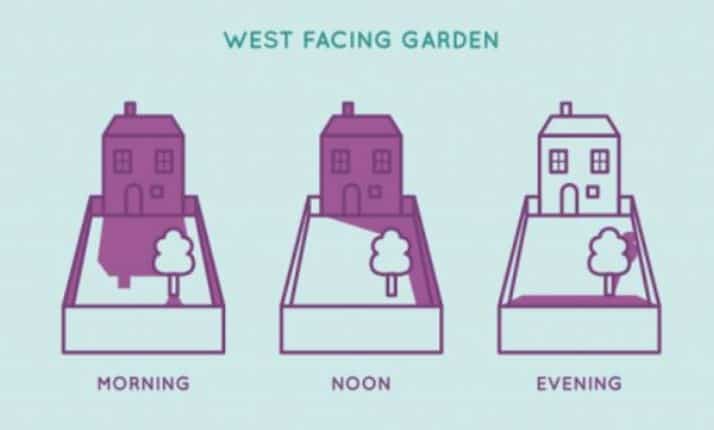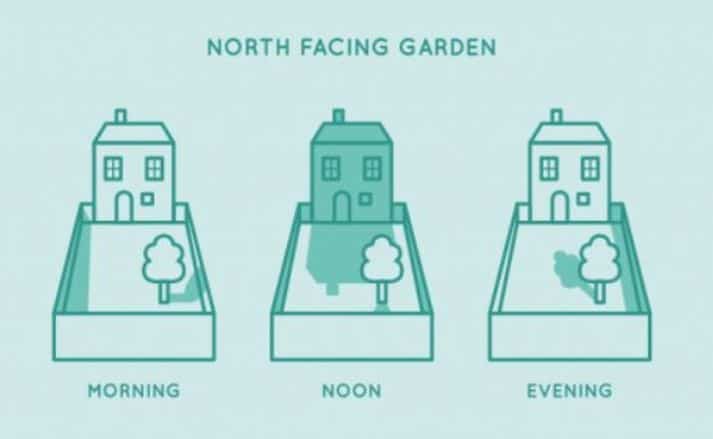Which Way Does Your Garden Face?
South, East, North, West
Why Is It Important?
Which way does my garden face?
This is the same as asking “What’s my garden aspect?” or “What’s my garden orientation?
So how do you know if you have a north facing garden, west facing garden, south facing garden, east facing garden, north east facing garden, north west facing garden , south west facing garden or even a south east facing garden? Why does it matter?
When planning and planting a garden, garden aspects are important to keep in mind. The aspect of the garden and how the sun moves around the garden are key factors in designing a successful garden. Understanding the meaning of this can be confusing at first. It is basically referring to the position from which you look out into the gardens. So as you look at your garden the position you’re facing determines which direction your garden faces. We show you how the direction your garden faces affects your garden.
A gardener’s main challenge is to get to know his garden. Regardless of where you live in England, the orientation of your garden plays a huge role in both the benefits and problems you face, as well as the plants you can grow there. Many people dream of a sunny, sheltered garden facing south, however facing south can present its own challenges, while facing east, west, and even north can be extremely productive and attractive as well.
How to determine which way your garden faces
Stand by your home’s back wall and use a compass to figure out the aspect of the garden. Here’s how to read a compass. A compass has a needle which always points North so align the compass and needle to “N”, whatever direction is directly in front of you is your garden’s aspect.
You can use your smartphone with a compass app installed and then you follow the same process as mentioned above.
Regardless of the compass, it is possible to make an educated guess about the aspect of your garden just by looking at the position of the sun and the shade cast during the day and throughout the year. As a general rule, the sun rises in the east and sets in the west.
Garden Aspects Explained
Depending on the aspect of your garden, the amount of sun and the amount of shade it receives will vary. Additionally, while it is critical to determine which way the garden faces, other factors play a significant role, too. In particular, all other trees and structures near the garden should be considered in order to determine what shade they may provide throughout the day and at different times of the year. If your home is a bungalow for example the it will cast less shade than if it were a two storey home.
In addition, choose plants that are suitable for their environment. Gardeners, even the most passionate ones, sometimes choose plants for the wrong aspect, resulting in plant suffering or even death. You can choose the right plants for your flowerbed if you know which plants need more or less light.
There are many challenges associated with shaded areas, but shade gardening also offers an array of opportunities.
What is a east facing garden?
An East facing garden is simply one that faces east, it will get most of its sun in the morning and will be in shade in the afternoon and evening. This kind of garden should consist mainly of plants that like partial shade and need shelter from intense sunlight when they grow. In the summer, a shaded area will protect plants from scorching. A dappled evening shade also attracts pollinating moths and other wildlife as well as enhancing the beauty of white flowers.
- In the morning, it will receive more sunlight, so you can enjoy breakfast outdoors!
- The evenings and afternoons will be darker.
- If you like to entertain in the evening, consider adding a fire pit to your landscape design and some garden lighting.

What plants can you plant for a east facing garden?
The following plants thrive in a garden facing east and are tolerant of the morning sun and cool weather:
- Honeysuckle
- Berberis
- Hydrangea.
- Lily of the Valley.
- Christmas fern.
What is a south facing garden?
South-facing gardens are those that face south. It is natural for many gardens not to face south in a straight line. Most are oriented slightly to the south-west or to the south-east. However, they are all referred to as ‘south-facing gardens.
Also, according to Rightmove, if you are lucky enough to have one, you could potentially add £22,000 to the value of your house. On average, properties with a south-facing garden have a price increase of $22,000 compared to similar properties without one.
- They are usually brighter since they receive more sunlight.
- In the early part of the season, it tends to be hotter and to warm up earlier.
- There is a possibility that they need more water since their soils tend to be drier.
- It can be difficult to set up shady seating areas as they can get very hot!

What plants for a south facing garden?
While many plants thrive in full sun, you do want to add a layer of mulch such as pebbles, bark, and gravel to increase water retention in your flower bed. The following plants are ideal candidates for a south facing garden:
While many plants thrive in full sun, you do want to add a layer of mulch such as pebbles, bark, and gravel to increase water retention in your flower bed.
- Irises
- Osteospermum (African Daisy)
- Achillea
- Creeping Phlox
- Delosperma
- Evening Primrose
- Verbascum
- Dahlias
There are plenty more plants to choose from.
What is a south-east facing garden?
A South-East facing garden is one that faces south-east. The characteristics are very similar to a south facing garden mentioned above.
With a south-east facing garden you can expect loads of sunshine throughout the morning, right up to late afternoon.
What plants for a south-east facing garden?
For a south-east facing garden you can plant the same plants as you would in a south facing garden, due to the fact that the environmental characteristics are very similar.
What is a west facing garden?
A West Facing garden is one that faces west, it will be mostly shady in the garden facing west in the mornings, but sunny in the afternoons and evenings. Plants in a garden that faces west need to be able to tolerate the intense afternoon sun during the summer, but they should also be able to tolerate the morning shade (or even enjoy it).
- Afternoons and evenings will be more sunny. This is ideal for a house party!
- In the morning it will be darker and the area nearest the house will be shaded.

What plants can you plant in a west facing garden?
West-facing gardens can support many beautiful and popular flowering plants. These are just a few ideas.
- Tulips.
- Geraniums.
- Daffodils.
- Roses.
- Jasmine.
- Magnolia.
There is no doubt that those are some of the most beautiful and fragrant flowers on earth.
What is a north facing garden?
Those gardens that face north are generally shaded for most of the day since your house is often between the sun and the garden. In the UK, however, until October, north-facing surfaces like your home’s back can receive morning and evening sunlight reasonably well.
- Reduces sunlight or causes dappled shade, which affects planting choices.
- It tends to be cooler early in the season and warm up later.
- Temperatures are less extreme highs and lows.
- The far end of longer gardens might get a large amount of light depending on what is around them.

What plants can you plant in a north facing garden?
A North Facing Garden is the perfect place for plants that thrive in shade or cooler temperatures. The following plants thrive in this area.
- Hostas
- Ferns
- Dicentra
- Vinca major
- Viburnum
- Erythronium (Dogtooth violet)
- Begonia
- Primula vulgaris
- Aquilegia vulgaris
